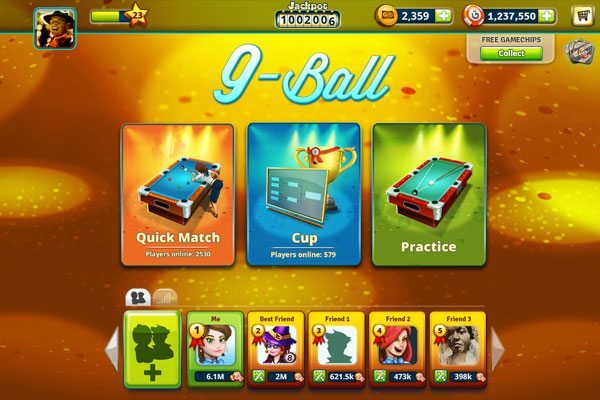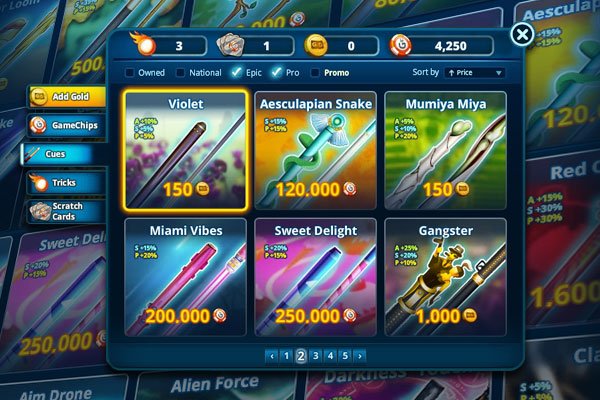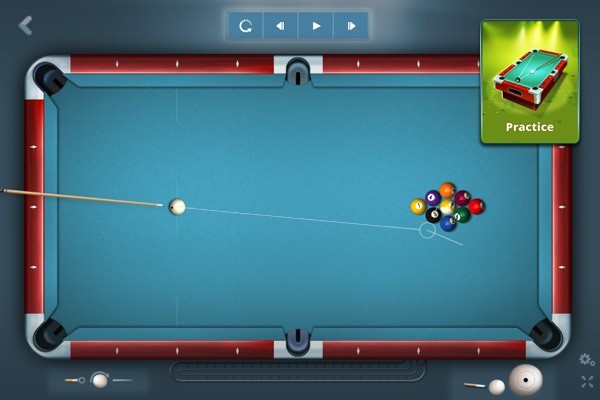9-ball rules - game rules
 Introduction
Introduction
9-Ball is a two-player billiards game played on a table with six pockets using nine numbered balls and a cue ball. The balls are numbered from 1 to 9. The cue ball is white and is not numbered. Players pocket the nine different balls by striking the cue ball with a cue stick.

 Game Objective
Game Objective
The objective of 9-Ball is to pocket the 9-ball. The player that legally pockets the 9-ball first wins. The nine ball is yellow and is distinguished from the 1-ball by its stripe. 9-Ball is unique from other billiards games in that a player needs to only pocket a single ball, the 9-ball, in order to win the game. The 9-ball can be pocketed at any time during the game.
 Players Alternate Turns
Players Alternate Turns
Like other billiards games, players alternate turns. Once a player begins their turn, they are allowed to play and continue shooting until they miss a shot or commit a foul. (See the Foul section for fouls)
 Game Play
Game Play
The main rule to remember about 9 Ball is that, for every shot, the cue ball must first contact the lowest numbered ball on the table before contacting any other balls, otherwise it is a foul. The lowest numbered ball on the table does not have to be pocketed, only contacted first. Players can pocket any ball at any time, as long as the lowest numbered ball (also referred to as the 'object ball) on the table is the first ball to be contacted by the cue ball.
 The break
The break
The break is the very first shot taken at the table, when the white cue ball contacts the other balls that are in the rack. For the break, the cue ball must contact the 1-ball first. Since the objective of the game is to pocket the 9-ball, if the 9-ball is pocketed during a legal break, then the player that broke the rack automatically wins.
 The push-out
The push-out
After the break (regardless of the result), before the second shot of the game, the player at the table may call a "push-out." A push-out can be called by the breaking player if he legally pocketed a ball on the break, or by the non-breaking player if no ball was pocketed on the break. Calling a push-out for the shot after the break allows the player taking the shot to legally hit the cue ball in any fashion. Playing a push-out shot ends the player's turn and so the other player begins their turn. The main purpose of the push-out shot is to help fix a bad layout after the break, where it is difficult to make a legal shot. Unlike any other shot of the game, for a push-out shot, the cue ball doesn't have to contact any certain ball and whatever object ball is contacted doesn't have to be the lowest numbered ball. If the nine-ball is pocketed on a push-out shot, it is considered "spotted". However, any other pocketed object ball remains pocketed and is not "spotted". After a push-out shot is called and played, the incoming player has the choice of accepting the table as it lies, or forcing the push-out player to take the next shot of the game (always the third shot of the game). Only one push-out is allowed per game, and it must be immediately taken after the break.
 Fouls
Fouls
- The break is the very first shot taken at the table, when the white cue ball contacts the other balls that are in the rack. For the break, the cue ball must contact the 1-ball first, and at least four balls must contact the rails. The rails are the sides of the pool table.
- A scratch is when the cue ball is pocketed. A player that scratches loses their turn. The opposing player may then place the cue ball anywhere on the table.
- If the first ball contacted by the cue ball is not the lowest numbered ball on the table, a foul is committed and the player loses their turn. The opposing player begins their turn and may place the cue ball anywhere on the table.
- For every shot, either the cue ball or at least one other ball must contact a cushion, otherwise it is a foul. The one exception to this rule is when a ball is legally pocketed with no foul occurring. In that case, no ball needs to contact any cushion.
- With every shot taken, the cue ball must contact at least one other ball, otherwise it is a foul.
- If a player commits three fouls in a row, they lose the game.
- If a player commits several fouls in one shot, they are counted as one foul.





